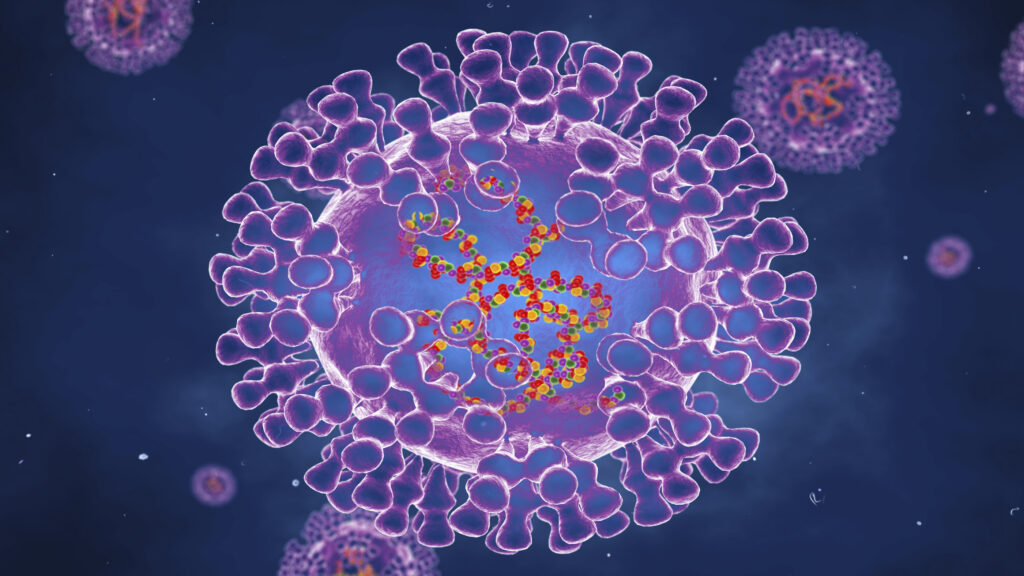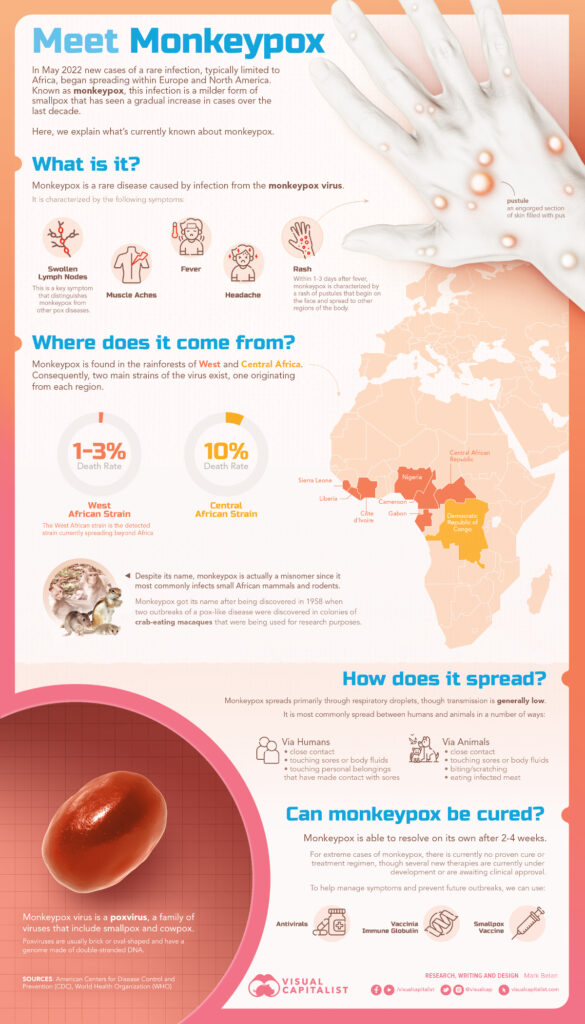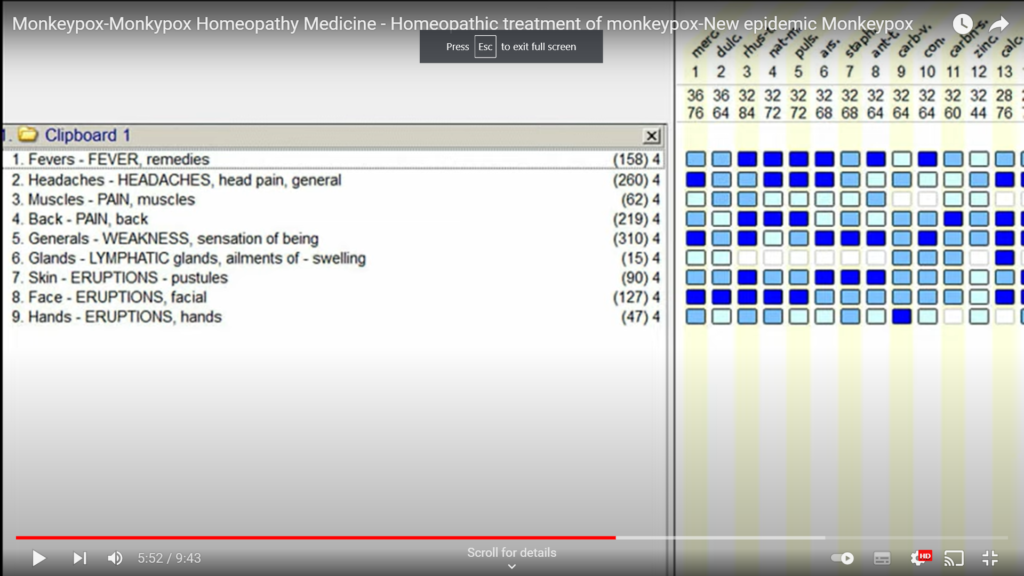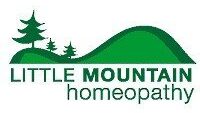In this article, learn about the basics of mpox (formerly known as monkeypox), including what the most common symptoms of the disease are as well what the most commonly indicated homeopathic remedies are for monkeypox.

About Monkeypox
Monkeypox was first discovered in 1958 when two outbreaks of a pox-like disease occurred in colonies of monkeys kept for research, hence the name ‘monkeypox.’ The first human case of monkeypox was recorded in 1970 in the Democratic Republic of Congo during a period of intensified effort to eliminate smallpox. Since then monkeypox has been reported in humans in other central and western African countries.
Monkeypox is a rare disease that is caused by infection with monkeypox virus.
About Genus Orthopoxvirus
The genus Orthopoxvirus contains a number of species that can infect animals and humans. The most well known member of the genus is variola virus, the causative agent of smallpox. Other notable members include vaccinia virus which is used in the current smallpox vaccine; cowpox virus, first introduced by Edward Jenner in the late 18th Century as the material of the first vaccine; and monkeypox virus.
Monkeypox Signs and Symptoms
In humans, the symptoms of monkeypox are similar to but milder than the symptoms of smallpox. Monkeypox begins with fever, headache, muscle aches, and exhaustion. The main difference between symptoms of smallpox and monkeypox is that monkeypox causes lymph nodes to swell (lymphadenopathy) while smallpox does not. The incubation period (time from infection to symptoms) for monkeypox is usually 7−14 days but can range from 5−21 days.
The illness begins with:
- Fever
- Headache
- Muscle aches
- Backache
- Swollen lymph nodes
- Chills
- Exhaustion
Within 1 to 3 days (sometimes longer) after the appearance of fever, the patient develops a rash, often beginning on the face then spreading to other parts of the body.
Lesions progress through the following stages before falling off:
- Macules
- Papules
- Vesicles
- Pustules
- Scabs
The illness typically lasts for 2−4 weeks. In Africa, monkeypox has been shown to cause death in as many as 1 in 10 persons who contract the disease.

Risk mitigation
Health authorities recommend the smallpox vaccination to those who are at risk of exposure to monkeypox.
The homeopathic nosodes Malandrinum and Variolinum have both been used successfully in the past for the homeoprophylaxis of smallpox.
Homeopathic prescribing for pox-associated diseases
Homeopathy produces its best results when remedies are matched to symptoms rather than disease names.
Chickenpox, monkeypox, buffalopox, horsepox, camelpox, cowpox, smallpox, vaccinia virus, herpes and shingles each have one symptom in common- the production of blistering vesicles known as poxes that fill with fluid or pus.
The choice of which one to use is made by matching the remedy to other presenting symptoms as well as the symptom of pox.
Homeopathic repertorization of common monkeypox symptoms

Top homeopathic remedies for monkeypox
According to what is known about the symptoms of monkeypox, the top homeopathic remedies for monkeypox to consider include:
Merc sol. This remedy covers all the symptoms of monkeypox the best and should be the #1 remedy to consider first. This is a common remedy for chickenpox. Characteristic symptoms include offensive, profuse sweat, large eruptions with profuse sores that can become open wounds, swollen lymph nodes, symptoms worse at night as well as worse from becoming chilled or overheated.
Dulcamara is a common remedy for shingles, and also covers the symptoms of monkeypox. Think of this remedy if symptoms develop after exposure to cold wet weather. Eruptions get worse at night and better by moving about and from external warmth. The eruptions are thick, crusty, moist and get worse before menses (in women). The crusts over the blisters are thick and brownish –yellow which starts bleeding when scratched.
Rhus Tox is the #1 remedy for chickenpox and it also covers the symptoms of monkeypox very well. Characteristic symptoms include burning intense itching that grows worse from scratching at night, and at rest. The eruptions can be large and pus-filled. The patient may be restless, and may have difficulties with falling to sleep and/or with staying asleep.
Natrum muriaticum is a common remedy used for herpes (cold sores). The eruptions contain watery, clear fluid. Vesicles with watery contents burst and leave thin scurf (flakes on the skin). The patient may have cracked lips and the eruptions are relatively painless.
Pulsatilla is another common remedy for chickenpox. Patients who need this remedy tend to be affectionate, gentle, sensitive and weepy, and have little thirst. Their symptoms tend to be worse in warm rooms and at night, and they feel better in open air.
Hepar sulph is a common herpes remedy, indicated for irritable patients whose eruptions are painfully sensitive to touch or cold.
Antimonium tart is the #1 remedy for smallpox and could be considered for monkeypox patients who have a rattling cough. Blisters tend to be large and they appear slowly.
Variolinum was the chief remedy used by Burnett for shingles. These are cardinal indications for Var.: Severe cold; chill; chilly creepings as if cold water were trickling down the back; violent fever with extremely hot skin, with or without high pulse. Violent headache. Nausea. Pain in epigastrium. Pain in limbs as if in bones. Severe backache. There may be rash or there may not.
Arsenicum is a common remedy for chickenpox. The eruptions tend to be large, with much pus, and can become open sores. The pains are burning and the patient is extremely chilly. Pains tend to be worse around midnight and in cold weather.
Other remedies to consider include: Thuja, Silica, Antimonium crudum, Sulphur, and Belladonna. Note that this list of remedies for Monkeypox is not exhaustive and that remedies should only be administered under the guidance of a professional homeopath.
Dislaimer: This article is a compilation of homeopathic professionals’ experiences with treating their patients with individually selected homeopathic remedies. This article is not intended as medical advice and does not substitute for the advice of a health practitioner. Health Canada has not authorized any NHP to treat, prevent or cure Monkeypox.
References and Further Reading
“All you need to know about Monkeypox and its homeopathic treatment” on Cliniconline.pk
“Everybody’s Guide to Homeopathic Medicines” by Stephen Cummings and Dana Ullman
“Homeopathy for any sort of pox” on Homeopathyplus.com
“Homeopathy for Smallpox” by Sonya McLeod
“Monkeypox” by CDC: Centers for Disease Control and Prevention
“Monkeypox virus” by Dr. Thind’s homeopathy treatment
“Top Homeopathic Remedies for Shingles” by Dr. Vikas Sharma
“Variolinum” in Materia Medica by John Henry Clarke
